AI tools are transforming college life in 2025, making it easier to manage assignments, research, and schedules - all for free. Whether it’s summarizing dense textbooks, organizing lecture notes, or refining essays, these tools simplify academic tasks and save time. Here’s a quick look at the best free AI tools available:
- AI Apps: A directory with 1,000+ AI tools tailored for students.
- Gemini 2.5 Pro: Google’s free assistant for research, writing, and coding.
- NotebookLM: Organizes and summarizes your uploaded documents.
- Otter AI: Transcribes lectures into searchable text.
- Grammarly: Improves writing clarity and grammar.
- ChatGPT: Answers questions, brainstorms ideas, and explains concepts.
- Socratic by Google: Solves math and science problems step by step.
- Doctrina AI: Simplifies research and academic writing.
- ChatPDF: Quickly extracts answers from PDFs.
- Natural Readers: Converts text to speech for audio learning.
These tools help students stay organized, improve productivity, and tackle coursework more efficiently. From writing essays to managing group projects, AI tools are now essential for academic success. Read on to discover how each tool works and how to use them effectively.
8 AI Tools for Students to Ace Any Subject FAST
AI Apps: The Central Directory for Student AI Tools
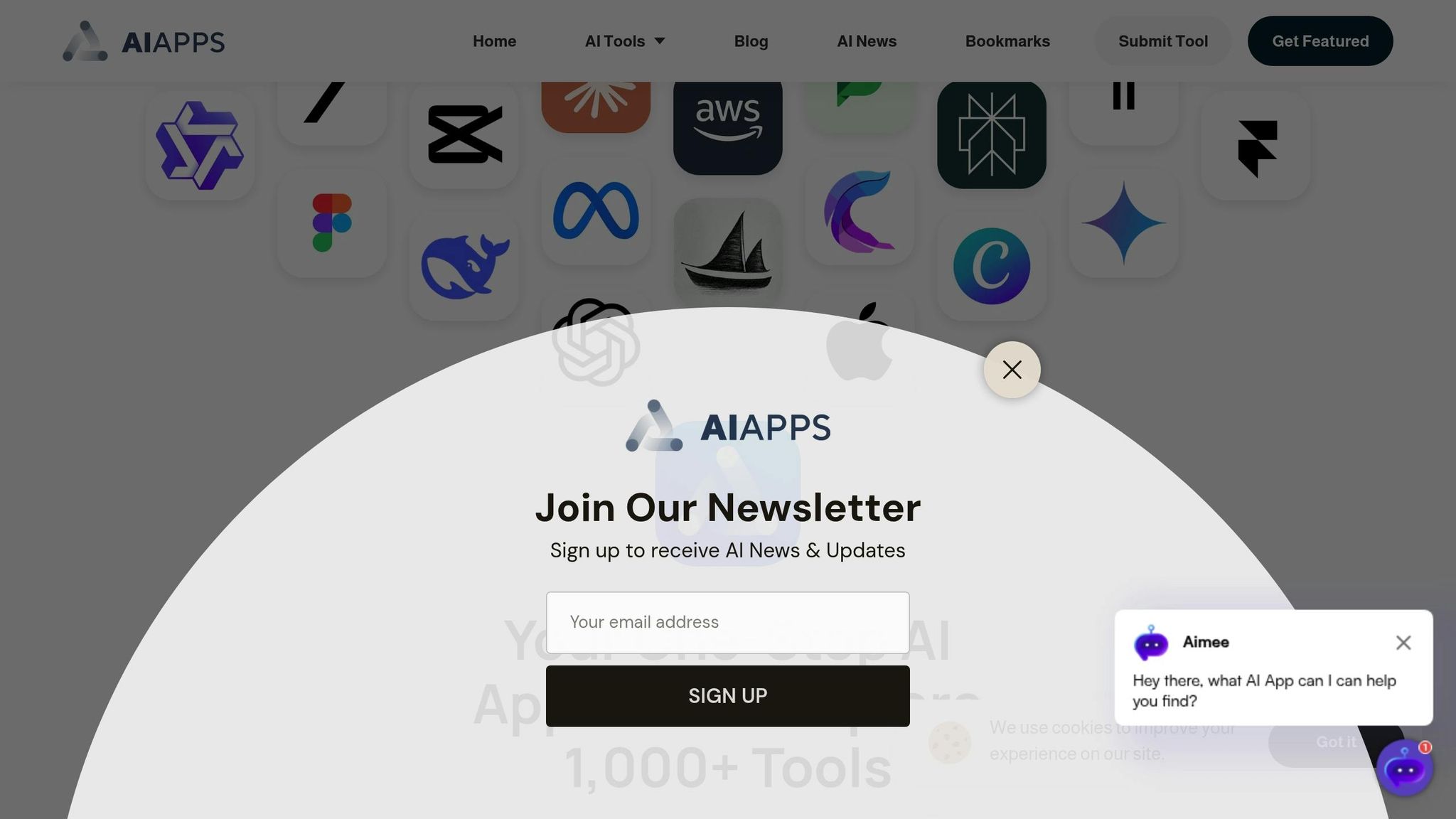
Finding the perfect AI tool online can feel like searching for a needle in a haystack. That’s where AI Apps steps in. Acting as a centralized hub, this platform brings together more than 1,000 carefully selected AI tools, all in one searchable location. Let’s dig into how AI Apps makes finding the right tool easier.
AI Apps offers a well-organized catalog tailored to student needs. Whether you’re tackling research, writing, note-taking, or managing projects, the platform categorizes tools into sections like AI Text Generators, AI Art Generators, and AI Video Tools. This clear structure means you can quickly find what you need without wading through irrelevant options.
For students on a tight budget, AI Apps includes advanced filters to help you zero in on free tools. Plus, every tool listed undergoes a multi-step verification process to ensure it’s reliable - saving you from potential headaches when deadlines are looming.
The platform also keeps you up to date by showcasing featured tools and the latest releases, so you’re always in the loop about new advancements in educational AI.
With clearly defined categories, AI Apps makes it simple for students to find tools that fit their academic goals. And with such a wide variety of resources, you might even stumble upon tools that transform how you work and study. Best of all, its free listings ensure that high-quality tools remain accessible to everyone, while encouraging the platform to continuously grow.
1. AI Apps
AI Apps is more than just a directory of tools - it’s a platform that helps students streamline their academic routines. With access to over 1,000 verified tools, it’s designed to make studying smarter and more efficient.
Tools Tailored for Academic Success
AI Apps organizes its extensive library into user-friendly categories like text, video, and art, making it easy to find tools that align with specific academic needs.
- The AI Text Generators section includes writing assistants, essay planners, and citation tools, perfect for tasks like drafting essays or managing references.
- AI Video Tools offer resources for creating presentations and other educational content, ideal for multimedia projects.
- For those in fields like visual arts or marketing, the AI Art Generators provide creative solutions for project work and assignments.
This categorization ensures that students from all disciplines can find tools that directly support their studies.
Free Access and Budget-Friendly Options
AI Apps is free to use, providing access to its full directory without any cost. The platform’s filtering system is particularly helpful for students on a tight budget, allowing them to search specifically for tools that don’t require subscriptions.
It’s worth noting, though, that while AI Apps itself is free, individual tools listed in the directory may have their own pricing models. The advanced filters help users quickly identify free tools, saving time and avoiding frustration.
Features That Stand Out for Students
AI Apps is designed with students in mind, offering features like:
- Advanced filtering: Easily find tools tailored to specific academic needs, whether it’s text analysis for literature majors or calculation tools for engineering students.
- Regular updates: New tools are featured prominently on the homepage, ensuring students stay up-to-date with the latest resources.
- Developer submissions: The directory grows continuously as developers add new tools, keeping the platform fresh and relevant.
These features make it a go-to resource for students looking to enhance their academic toolkit.
Simplifying the Study Routine
AI Apps is built to integrate effortlessly into a student’s daily workflow. By centralizing a wide range of tools, it eliminates the need for endless online searches, allowing students to focus on their studies.
Students can bookmark their favorite tool categories to create a personalized dashboard, saving time and making it easier to dive straight into coursework. Whether you’re tackling a research paper or designing a creative project, AI Apps ensures you have the right tools at your fingertips.
2. Gemini 2.5 Pro
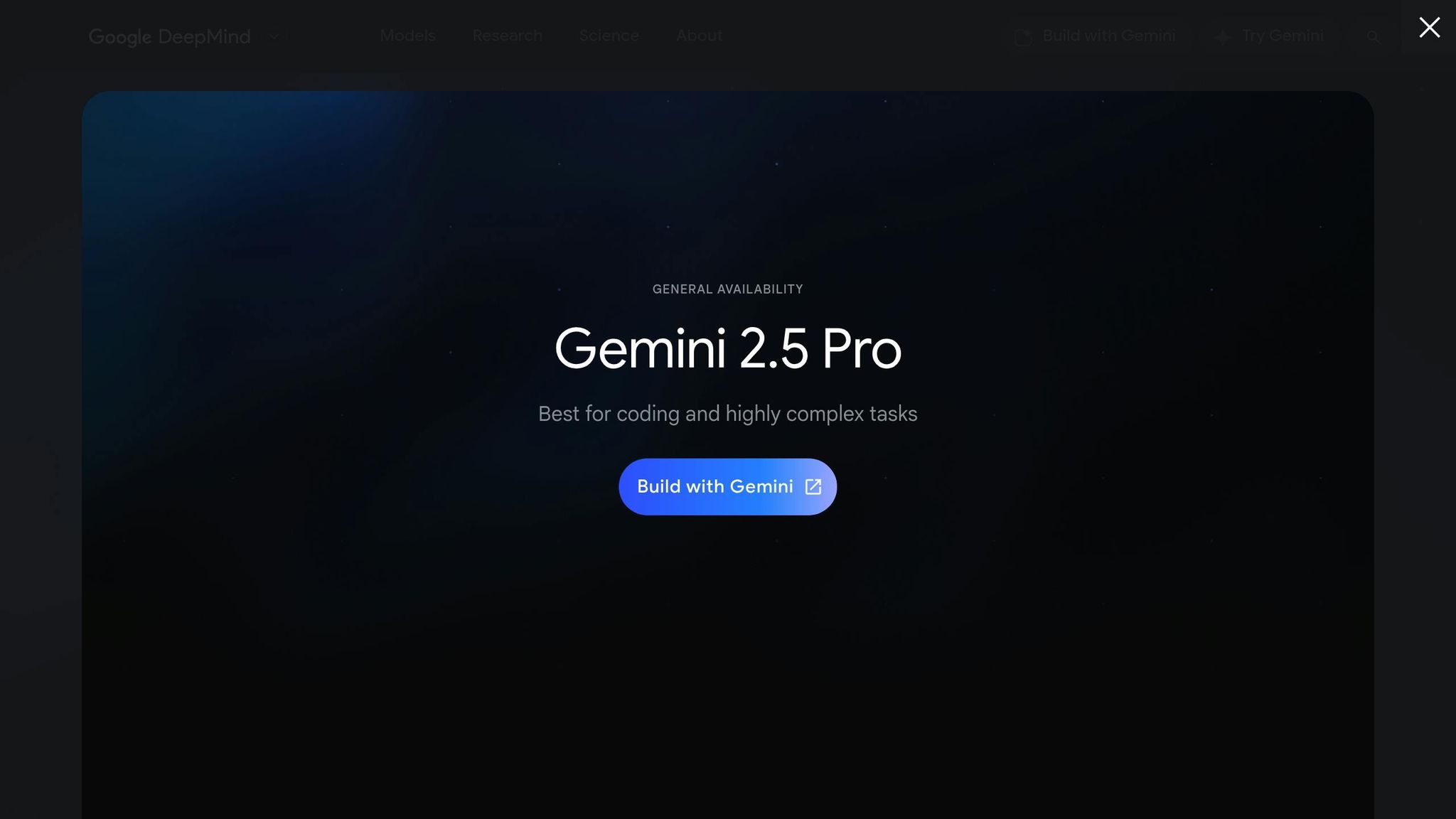
Google's Gemini 2.5 Pro is designed to tackle academic challenges head-on. This AI assistant stands out with its multimodal capabilities, meaning it can seamlessly process and combine different types of content - like text, images, and documents. This makes it a powerful tool for integrating course materials and conducting research. Plus, it's available for free on AI Apps, making it a practical option for students looking to boost their academic productivity.
Core Features for Academic Tasks
Gemini 2.5 Pro is a versatile assistant for students across disciplines. Whether you're working on a detailed research assignment or tackling a complex project, it can analyze and synthesize information to make your work easier. For STEM students, it offers problem-solving support, while humanities students can rely on it for literary analysis and more.
Free Access for Students
One of the most appealing aspects of Gemini 2.5 Pro is its free usage tier. This option ensures students can access its features to handle everyday academic tasks without worrying about extra costs.
Features Tailored for Students
Here are some standout features that make Gemini 2.5 Pro a valuable academic tool:
- Multimodal processing: Handles a variety of academic content types - text, images, and more - all at once.
- Code analysis and debugging tools: Perfect for computer science and engineering coursework.
- Writing support: Provides targeted feedback to help students refine and structure their assignments.
Enhancing Academic Workflow
Whether you're diving into research, collaborating on group projects, or revising your work, Gemini 2.5 Pro simplifies the process. Its features are designed to streamline academic tasks, making it easier to stay organized and efficient throughout your studies.
3. NotebookLM
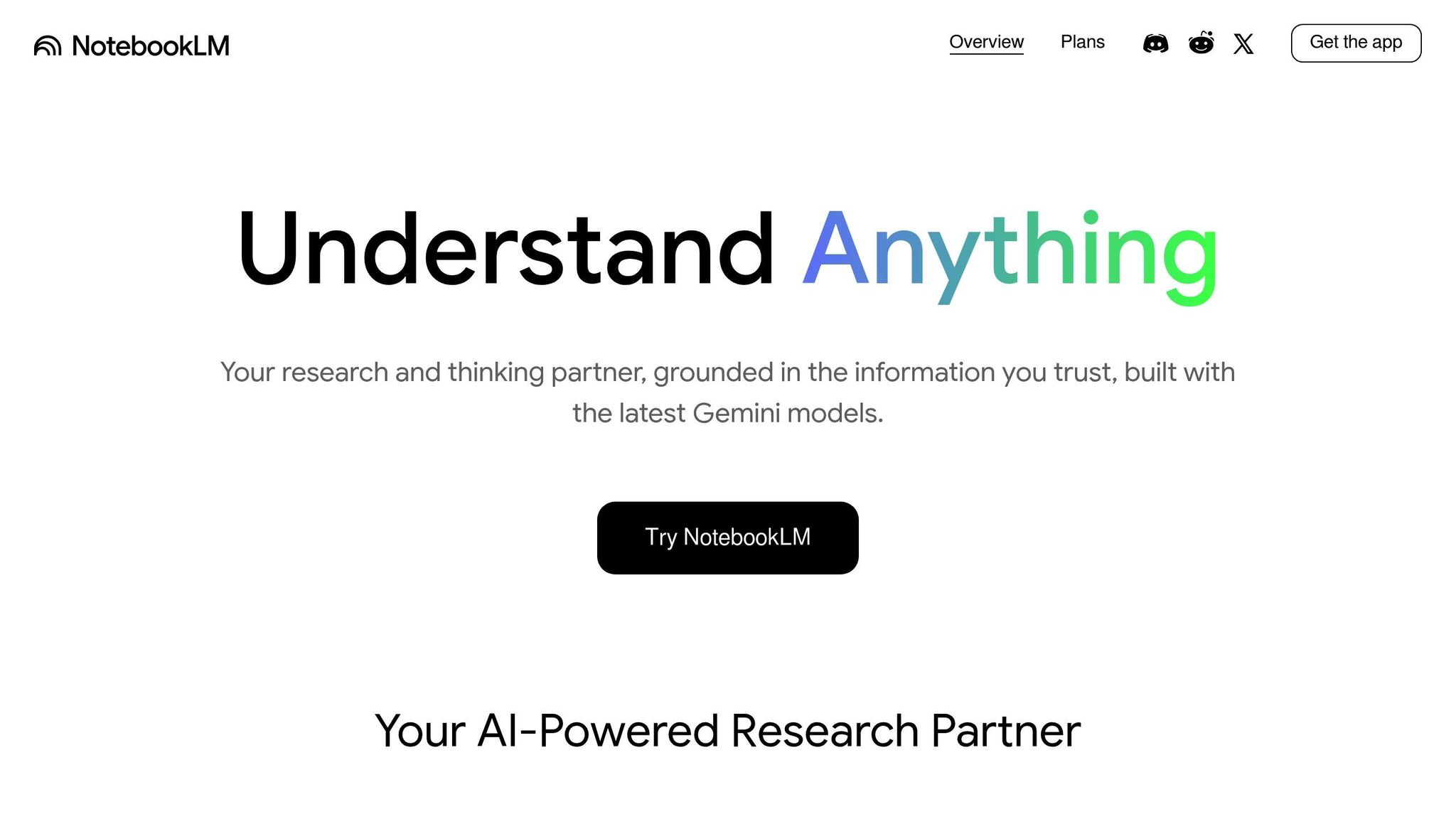
NotebookLM takes what Gemini 2.5 Pro offers and shifts the focus to academic research, creating a tool specifically designed for students and researchers. This AI-powered assistant from Google works directly with your uploaded documents, ensuring that its responses are grounded in the material you provide. By anchoring its answers to your files and including citations, it’s an excellent resource for academic work. With tens of thousands of schools already using NotebookLM, it’s quickly becoming a go-to tool for students aiming to streamline their research and study processes.
Core Features for Academic Success
NotebookLM transforms dense academic materials into more accessible, interactive content. It can summarize documents into concise overviews, making it easier to digest large amounts of information. Plus, it answers specific questions with accurate citations - a handy tool for reviewing textbooks or preparing for exams.
One standout feature is its mind map generation, which creates visual diagrams to help students break down complex topics and see connections between ideas. This visual approach is particularly helpful for subjects with layered or interconnected concepts. Another unique offering is NotebookLM’s ability to provide audio summaries, turning written material into a conversational format. This feature is perfect for reviewing content while on the go, whether commuting or working out.
Tailored Features for Students
NotebookLM shines in handling complex PDFs, including those with images, graphs, and technical data. This makes it especially useful for STEM students who often work with challenging materials. It supports a variety of document types, allowing students to upload lecture slides, research papers, and textbook chapters into one organized workspace.
Additionally, its April 2025 update introduced a feature that helps students find supplementary study materials within NotebookLM itself. This is a game-changer for research projects, as it allows users to discover additional sources and perspectives directly through the platform.
Seamlessly Fitting Into Academic Workflows
To get the most out of NotebookLM, students should upload focused and reliable materials that align with their academic goals. Asking precise questions - like “Compare and contrast Document 1 with Document 2” or “Simplify this concept for me” - can lead to more targeted and insightful responses.
For group projects, NotebookLM offers shared notebooks, enabling team members to collaborate effectively by interacting with the same set of materials. This feature makes it easier to explore course content together and ensures everyone stays on the same page. To optimize study sessions, it’s a good idea to upload all necessary documents ahead of time, giving NotebookLM the chance to process and analyze the content thoroughly.
While NotebookLM is a powerful study aid, it’s designed to complement traditional learning methods. It encourages active engagement and collaboration, while leaving room for critical thinking and deeper understanding.
4. Otter AI

Otter AI changes the way students handle lecture notes by converting spoken words into searchable transcripts. With this tool, students can focus more on understanding the material rather than scrambling to jot down every word - a lifesaver for fast-paced classes.
Core Functionality for Academic Use
Otter AI shines in its ability to accurately turn speech into text. Students can record lectures and instantly generate transcripts for later review. It even identifies different speakers, making it especially useful in group discussions or classes where multiple voices contribute.
What’s more, students can highlight key moments during the lecture and add their own comments directly to the transcript. This creates a study resource that combines the original lecture with personal insights, making it easier to revisit and understand the material.
Free Usage Limits or Restrictions
The free version of Otter AI offers 600 minutes of transcription per month, which translates to about 10–15 hours of lectures. However, individual recordings are capped at 40 minutes, so for longer lectures, students will need to restart the recording or break sessions into smaller chunks.
Additionally, the free plan allows three audio file imports per month, making it possible to upload recordings from other devices or files shared by professors. While advanced collaboration tools like shared folders are not included in the free tier, students can still share individual transcripts with classmates or study partners.
Key Features for Students
Otter AI goes beyond simple transcription with features tailored to students’ needs:
- Keyword search: Quickly find specific topics or concepts within a lecture, saving time during exam prep.
- Summary generation: Automatically creates concise overviews of longer recordings, highlighting key points and main ideas.
- Custom vocabulary lists: Helps Otter AI recognize specialized terms, which is especially useful for technical subjects like medicine, law, or engineering.
- Mobile and cross-device access: Record on a phone during class and review the transcript later on a laptop or tablet.
These features make Otter AI a practical tool for students juggling multiple courses and study materials.
Integration into Academic Workflow
Otter AI fits seamlessly into a student’s academic routine. To get the most out of it, students should consistently record all lectures and important discussions. Organizing transcripts into folders for each course and giving recordings clear, descriptive titles makes it easier to find specific content later.
For group projects, Otter AI simplifies collaboration. Students can share transcript links with team members, ensuring everyone has access to the same notes from meetings or brainstorming sessions. Transcripts can also be exported as text files, allowing integration with other tools like note-taking apps or study platforms.
To ensure accurate transcription, it’s best to place the recording device close to the speaker and limit background noise. Real-time editing can also help correct any errors on the spot, making the final transcript more reliable.
Otter AI is a powerful addition to any student’s toolkit, streamlining the process of capturing, organizing, and reviewing lecture content.
5. Grammarly
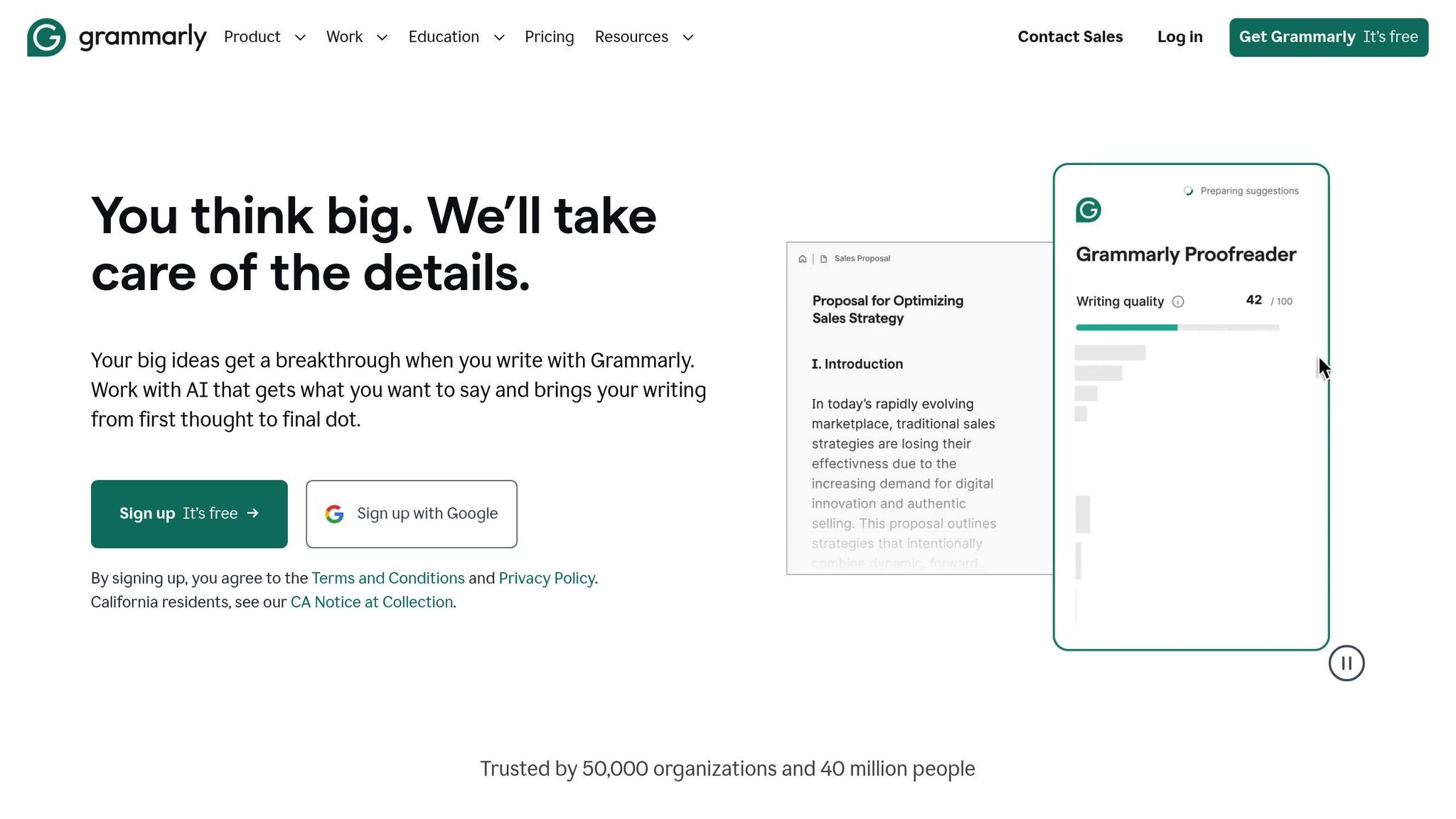
Grammarly is a helpful tool for college students looking to refine their writing. This AI-powered assistant works across platforms, offering real-time suggestions to improve essays, research papers, and even emails. It goes beyond standard spell-check to enhance clarity and polish.
Core Features for Academic Writing
Grammarly does more than just flag spelling and grammar errors - it provides context-specific suggestions to improve tone, punctuation, and word choice. For example, it can suggest concise alternatives to overly wordy phrases, making it especially useful for meeting word count limits in assignments.
Another standout feature is tone detection. Grammarly helps students assess whether their writing feels confident, formal, or overly casual. This is particularly useful for crafting professional emails to professors or fine-tuning the tone of academic papers.
The tool also encourages concise communication by identifying redundant language, a skill that’s critical for effective writing in college.
Free Plan Limitations
Grammarly’s free version offers a "free-forever" plan but comes with some restrictions:
- Process up to 300 documents or 150,000 words every 30 days
- Process up to 100 documents or 50,000 words in a 24-hour period
- Accept files under 4 MB in formats like .doc, .docx, .odt, .txt, and .rtf
- Provide up to 100 AI prompts per month
However, it doesn’t support PDF, LaTeX, or Markdown files, and while it can detect plagiarism, it won’t highlight specific problematic sections or provide sources.
Features Tailored for Students
Grammarly’s free tier includes several tools that align well with student needs:
- Spelling and grammar checks: These catch common mistakes, offering explanations so students can learn from their errors instead of just correcting them.
- Tone detection: This feature helps students adjust their writing to suit the audience, whether for casual group chats or formal academic work.
- Citation suggestions: While not as detailed as specialized tools, this feature offers basic guidance on proper source attribution.
- Cross-platform availability: Grammarly can be accessed via browser extensions, mobile apps, and desktop applications, making it easy to use whether you’re working in the library or on the go.
These features make Grammarly a flexible companion for everyday academic writing.
Incorporating Grammarly into Your Workflow
Many students find it helpful to use Grammarly as a post-writing tool. Instead of relying on real-time suggestions while drafting, you can turn the tool off during initial writing sessions and activate it later for edits and revisions. This approach allows you to focus on your ideas without distractions.
Taking the time to review Grammarly's explanations for each suggestion can also help you build a stronger understanding of grammar and style over time. This way, you gradually reduce your reliance on the tool for future assignments.
For group projects, Grammarly ensures your shared documents are free of basic errors, giving you confidence in your submissions. It’s also handy for writing emails to professors, posting on discussion boards, or submitting assignments online.
To get the most out of the monthly AI prompt allocation, use these strategically. Save prompts for brainstorming essay topics, crafting thesis statements, or tackling challenging assignments. This ensures you have resources available when working on high-stakes projects.
Grammarly is more than just a spell-checker - it’s a writing assistant that helps students produce cleaner, more polished work while improving their skills over time.
6. ChatGPT
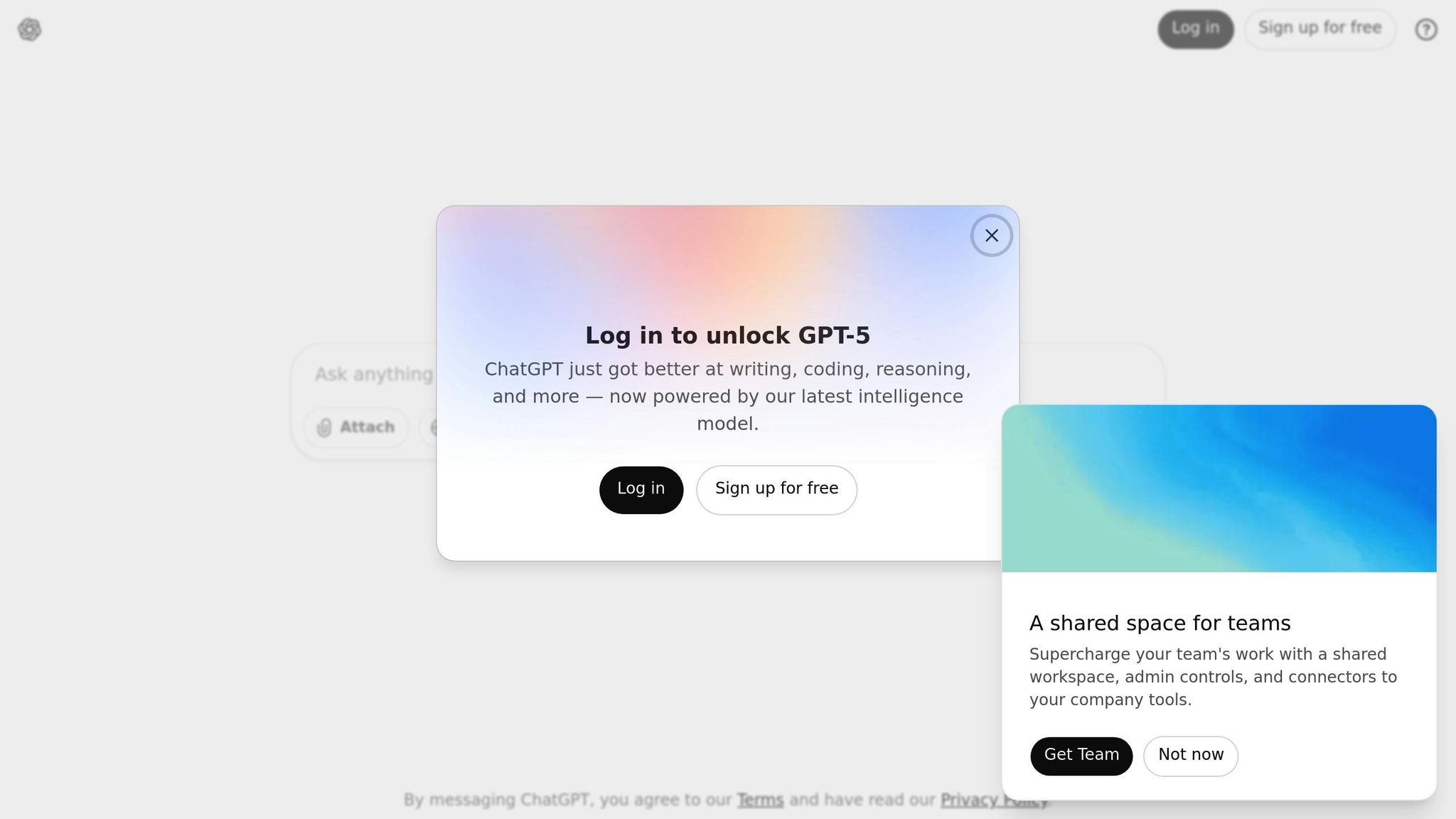
ChatGPT is an AI-powered conversational assistant that’s especially handy for college students. Available for free through the AI Apps directory, it’s a go-to tool for everything from brainstorming essay ideas to breaking down tricky concepts. Here’s a closer look at how ChatGPT can streamline your academic life.
Core Functionality for Academic Use
ChatGPT shines when it comes to simplifying complex topics. Whether you’re grappling with advanced math, unraveling historical events, or analyzing literature, it provides clear, step-by-step explanations that are easy to follow.
What sets ChatGPT apart is its ability to engage in interactive conversations. Unlike search engines that deliver static results, ChatGPT lets you ask follow-up questions, request clarifications, or dig deeper into specific aspects of a topic. This makes it an excellent tool for research and understanding nuanced ideas.
Free Usage Limits or Restrictions
The free version of ChatGPT does come with a few limitations. During peak times, responses may be slower, and message limits might apply. Additionally, file uploads aren’t supported, and free users have access to GPT-3.5, which lacks some of the advanced features found in newer versions.
Key Features for Students
ChatGPT offers a range of features tailored to student needs:
- Concept explanations: It simplifies everything from quantum physics to Shakespeare by using analogies and examples that make sense.
- Study support: Use it as a study buddy to quiz you, create practice questions, or review key concepts before exams. It even adjusts the difficulty based on how well you’re doing.
- Writing and research help: Whether you need an outline, a thesis suggestion, or feedback on your argument structure, ChatGPT can assist. It’s great for identifying themes, exploring different perspectives, and connecting ideas. While it’s not a substitute for primary research, it’s a great jumping-off point for deeper exploration.
Integration into Academic Workflow
Incorporating ChatGPT into your study routine can make assignments less daunting. By sharing details about your course, assignment, or specific challenges, you’ll get responses tailored to your needs.
Use it to brainstorm ideas, build outlines, and break large projects into smaller, manageable tasks. For instance, pre-writing sessions can help you explore different angles, craft thesis statements, or create detailed outlines before diving into your draft.
It’s also a great tool for enhancing study groups. ChatGPT can generate discussion questions or offer multiple explanations for challenging topics, helping group members approach concepts in ways that resonate with them.
sbb-itb-212c9ea
7. Socratic by Google
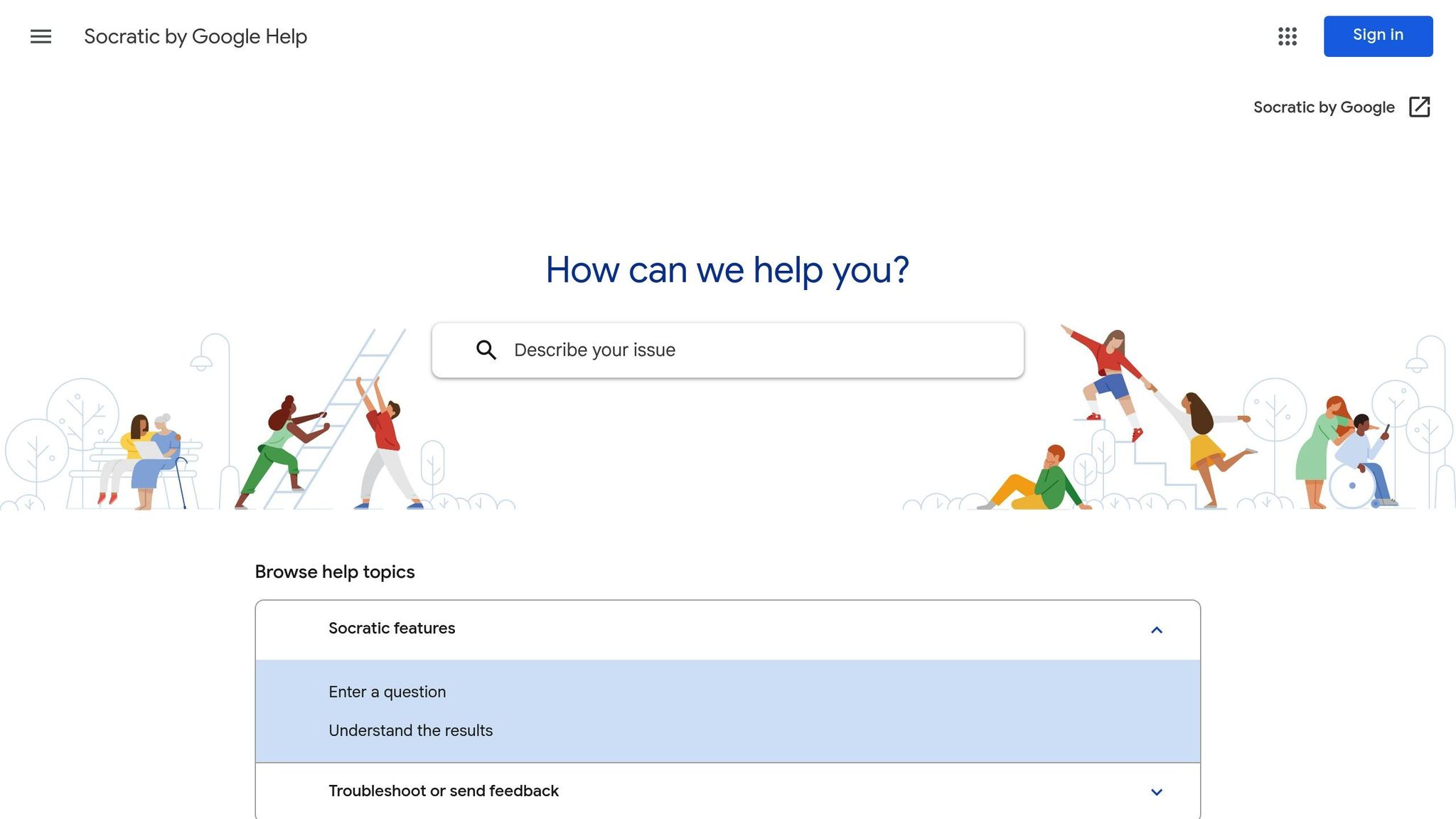
Socratic by Google is a mobile app designed to help college students tackle homework challenges and study more effectively. Available for free, this AI-powered tool uses Google's advanced technology to provide step-by-step explanations and visual aids, making even the most complex topics easier to grasp.
How It Works for Academic Success
Socratic simplifies the learning process by allowing students to snap a photo of a homework question or type it out. The app then delivers detailed, step-by-step explanations tailored to the problem. This approach is especially helpful for subjects like math, chemistry, and physics, where visual elements like formulas and diagrams are essential.
What sets Socratic apart is its ability to recognize handwritten text and equations, making it compatible with both physical textbooks and handwritten notes. This adaptability ensures that students can seamlessly incorporate the app into their study routines.
Features That Stand Out
Socratic is packed with features designed to support students in their academic journey:
- Step-by-step solutions: Instead of just giving answers, the app walks students through the entire problem-solving process, helping them understand the "why" and "how" behind each solution.
- Visual explanations: Diagrams, charts, and illustrations are used to break down complex mathematical steps or scientific concepts, making them easier to follow.
- Subject-specific resources: The app pulls content from trusted educational sources, offering additional reading materials, videos, and practice problems. This variety of resources gives students multiple ways to approach and understand challenging topics.
These features not only make learning more engaging but also help students build a stronger foundation in their subjects.
A Study Companion Anywhere, Anytime
Socratic fits naturally into any study routine, whether it's for tackling daily homework or preparing for exams. During homework sessions, it provides quick, reliable explanations to help students overcome tricky problems. For exam prep, students can photograph practice questions from old exams or textbooks to receive detailed solutions, giving them a better grasp of the material and strategies for similar problems in the future.
The app's mobile-friendly format ensures that students can access it wherever they are - whether at home, in the library, or even between classes. This flexibility makes it an essential tool for staying on top of academic demands without being tied to a specific location or device.
8. Doctrina AI
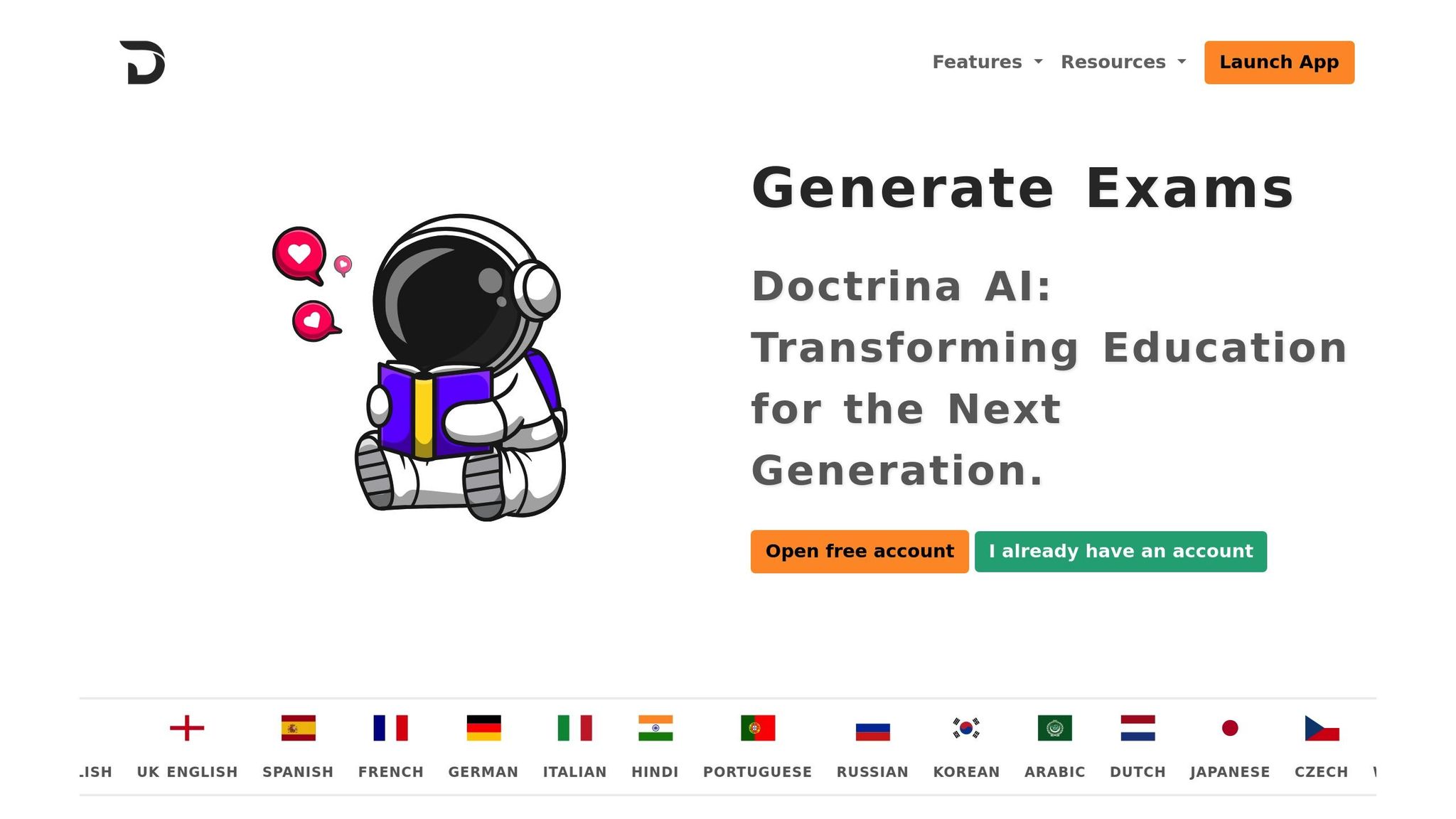
Doctrina AI is designed to assist with research, academic writing, and in-depth content review. It helps users explore topics, organize their writing, and break down complex material into easy-to-digest summaries and study guides - all through an intuitive interface.
The platform follows a freemium model, meaning it offers a range of basic features at no cost, while premium options provide additional tools for organizing information and simplifying intricate concepts.
At its core, Doctrina AI is built to help students tackle their coursework more effectively and achieve better academic results. Like other tools in this space, it focuses on making academic tasks less overwhelming and enhancing study productivity.
9. ChatPDF
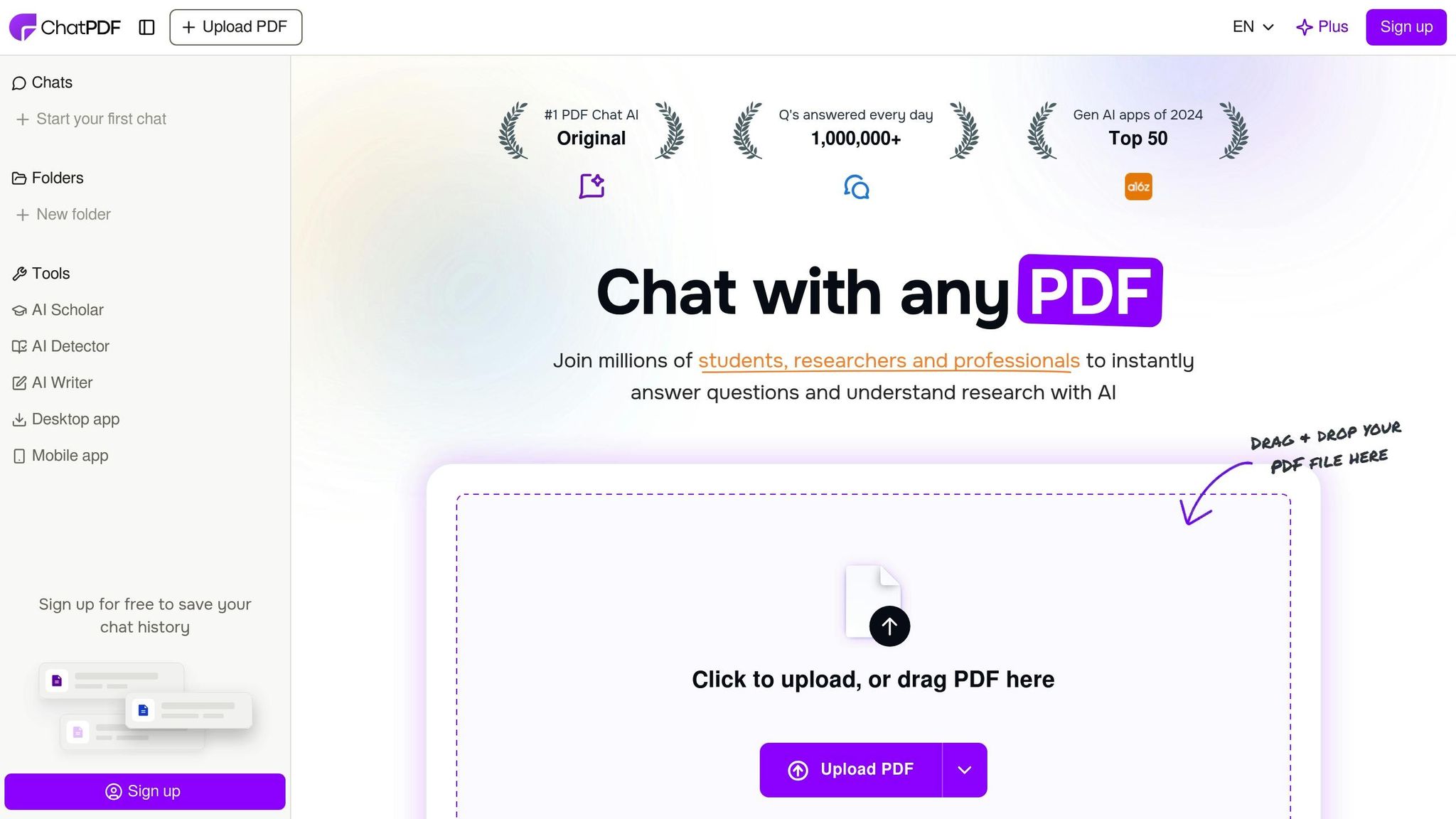
ChatPDF simplifies the way students engage with academic PDFs by offering a chat-based interface. You can ask questions in plain, everyday language, and it provides instant answers based on the document's content. No more endless scrolling through dense research papers or textbooks - this tool makes finding the information you need fast and effortless. It's a handy addition to the growing range of AI tools aimed at making academic tasks easier to manage.
10. Natural Readers
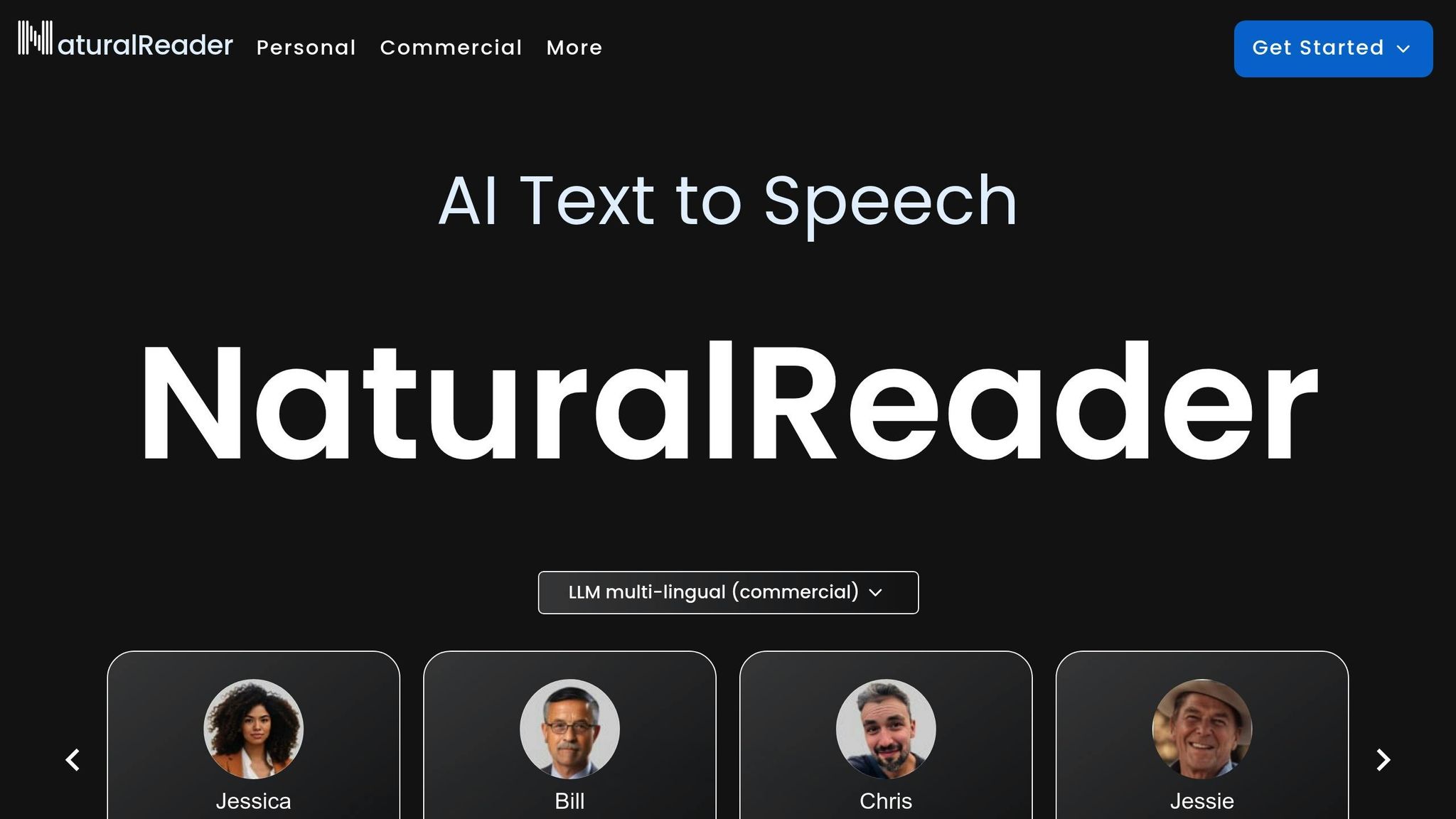
Natural Readers is another helpful free AI tool that turns text into speech, making it easier for students to absorb material while multitasking. Whether you're commuting, exercising, or just prefer audio learning, this text-to-speech tool transforms study materials into audio content you can listen to on the go. It supports various file formats and offers customizable voice options to suit your preferences.
How It Works for Academic Use
Natural Readers is designed to convert textbooks, research papers, lecture notes, and study guides into audio files. You can upload PDFs, Word documents, or even paste text directly into the platform. The tool is capable of accurately pronouncing academic terms, and you can adjust the playback speed to match your needs. For students with dyslexia or other reading challenges, this feature provides an alternative way to access course materials.
A standout feature is its OCR (Optical Character Recognition) technology, which extracts text from scanned documents. This is especially useful for older textbooks or handwritten notes that aren't available in digital formats, making them accessible in audio form.
Free Version: What You Get
The free version of Natural Readers allows up to 20 minutes of audio conversion per day, which is enough time to review important sections of study material. Basic voice options and standard reading speeds are included in this tier.
You can process documents up to 5,000 characters at a time, or roughly 2-3 pages of typical academic text. While longer documents need to be broken into smaller sections, this can actually make studying more manageable by encouraging you to focus on smaller chunks of material.
Features That Stand Out for Students
Natural Readers includes several tools that make it especially useful for academic work:
- Pronunciation assistance: Ideal for complex academic terms, scientific names, or foreign language words.
- Text highlighting synced with audio: Helps you follow along and stay focused.
- Speed control: Adjust playback speed from 0.5x to 3x, slowing down for challenging sections or speeding up for review.
- Multi-language support: Great for students tackling materials in different languages.
- Offline access: Create and download audio files to study anywhere, even without an internet connection.
Adding Audio Learning to Your Study Routine
Natural Readers is an excellent tool for integrating audio learning into your study habits. Many students use it to review notes before exams while doing other tasks, like walking or organizing their workspace. By engaging a different sense - hearing - it helps reinforce information and improve retention.
For research-heavy assignments, you can use Natural Readers to quickly screen sources by listening to abstracts or conclusions. This saves time and helps you identify the most relevant materials for deeper study.
The tool also pairs well with active learning strategies. For example, you could listen to a chapter or lecture notes to get a broad overview, then read the same material visually for a deeper understanding. This dual approach - combining listening and reading - can make complex topics easier to grasp. When combined with other AI-powered tools, Natural Readers helps you streamline your academic workflow and make the most of your study time.
How Students Use AI Tools in Practice
College students are finding inventive ways to incorporate AI tools into their academic lives, transforming how they study and manage their time. These tools, often discovered through platforms like AI Apps, are proving to be game-changers by simplifying tasks and boosting productivity. Let’s dive into some real-world examples of how students are weaving these tools into their daily routines.
Managing Research Projects with Multiple Tools
When tackling research projects, students often combine several AI tools to streamline their workflow. For instance, they might start by using ChatPDF to extract key insights from lengthy academic papers. Next, they turn to NotebookLM to organize and structure their findings. Finally, tools like Grammarly and Natural Readers come into play to refine their work, ensuring it’s polished and error-free.
Time Management and Study Scheduling
AI tools are also helping students master time management. Many begin their search for productivity solutions on AI Apps, which allows them to filter tools based on their specific needs and budgets. Once they find the right fit, students use these tools to create and fine-tune their schedules.
One standout tool in this category is Gemini 2.5 Pro, which has gained popularity for creating personalized study plans. By inputting details like course loads, assignment deadlines, and personal obligations, students can generate realistic study schedules. The tool can even break large projects into smaller, manageable tasks and adjust plans when unexpected events pop up.
Collaborative Group Projects
Group projects can be chaotic, but AI tools are helping students stay organized. Otter AI has become a favorite for study groups and team meetings. By recording discussions and generating transcripts, students can easily track decisions and assign tasks. This ensures everyone is clear on their responsibilities, reducing misunderstandings and missed deadlines.
Writing and Editing Workflows
Writing assignments are another area where students are leveraging AI tools effectively. Many use ChatGPT or Gemini 2.5 Pro during the brainstorming and outlining stages. For drafting, Grammarly helps catch errors and improve clarity, while Natural Readers provides an audio review to ensure the content flows smoothly and sounds natural.
Subject-Specific Applications
AI tools are also being tailored to specific academic disciplines. For STEM students, Socratic by Google offers step-by-step problem-solving assistance, making complex equations and concepts easier to grasp. Meanwhile, Doctrina AI is a versatile tool used across various subjects, simplifying tough topics into digestible explanations. Language and literature students often pair ChatPDF with Natural Readers to analyze and interpret texts more effectively.
Creating Efficient Daily Routines
By integrating these tools into their daily lives, students are crafting routines that enhance their productivity. For example, some begin their day by reviewing priorities with Gemini 2.5 Pro and end it by summarizing their notes with Natural Readers. These habits create a structured, cohesive workflow that supports academic success.
What stands out across all these examples is that successful students don’t rely on just one AI tool. Instead, they experiment with different combinations, building workflows that suit their unique learning styles and academic challenges. This approach allows them to tackle multiple aspects of their studies with efficiency and ease.
Tool Comparison Table
Here's a quick overview of AI Apps, a centralized directory that showcases more than 1,000 AI tools. The table highlights its primary function, standout features, free usage options, and additional notes:
| Tool | Primary Function | Key Features | Free Usage | Notes |
|---|---|---|---|---|
| AI Apps | AI Tool Discovery | Over 1,000 curated tools, advanced filtering, and category browsing | Unlimited browsing and search | Free basic listings; premium placement requires payment |
This table provides a concise look at what AI Apps brings to the table for anyone looking to expand their academic or professional toolkit.
How to Get the Most from Free AI Tools in College
Making the most of free AI tools during college requires a blend of strategy, creativity, and organization. Here’s how you can maximize their potential:
Stretch your free usage limits. Sign up for multiple tools and spread your workload across them to avoid running into usage caps. Keep a close eye on how much you’re using each tool and schedule your more intensive tasks - like research or writing - accordingly.
Pair tools for better results. For example, you can use one tool to transcribe lectures and another to summarize the content. This combination creates a more complete study system without spending a dime.
Check your college’s AI policies. Before diving in, make sure you understand the rules. Look at your syllabus or ask your professors about their stance on AI tools. Policies can vary widely, so it’s better to clarify early to avoid any issues later.
Plan for off-peak hours. Some free tools can slow down during busy times. Scheduling your work during quieter periods can help you avoid delays.
Create reusable prompts. Save time and ensure consistent results by developing template prompts for tasks like summarizing research papers or drafting essay outlines.
Blend AI with traditional methods. Use AI tools to generate practice questions or study guides, then complement this by jotting down handwritten notes. This way, you’re prepared for situations where digital tools aren’t an option.
To streamline your approach further:
- Use AI discovery apps. These apps can help you quickly find tools tailored to specific subjects or tasks.
- Track your tool usage. Keep a record of how effective each tool is for different assignments. This not only helps you stay organized but also ensures transparency in case you need to explain your methods.
- Engage with other students. Join online communities like subreddits or Discord groups to swap tips, share prompts, and learn from others’ experiences with AI tools.
Lastly, always have a backup plan. Free tools can sometimes face outages or restrictions, so it’s smart to prepare alternatives for critical tasks.
Conclusion
Higher education in 2025 is increasingly shaped by free AI tools that support academic success. These digital helpers can do everything from transcribing lengthy lectures to helping you outline essays in a pinch.
The best part? You don’t need a premium subscription or a big budget to access AI tools that can ease your workload, boost your grades, and reduce stress. Whether it’s breaking down dense textbook chapters into manageable study guides, organizing your thoughts for a paper, or tackling research challenges, there’s likely a free tool out there to fit your needs.
Start small. Choose one or two tools that solve your most pressing academic challenges - maybe it’s capturing notes during rapid-fire lectures or fine-tuning your writing before submitting assignments. Once you’ve mastered those, you can expand your toolkit gradually, adding tools that align with your study habits. This approach ensures every tool you adopt makes a meaningful difference in your academic life.
Remember, these tools are here to enhance your learning, not replace it. Let them handle the repetitive tasks, so you can focus on critical thinking, creativity, and truly understanding your coursework. The students who excel in 2025 aren’t necessarily the ones who study the longest - they’re the ones who use these tools wisely and uphold academic integrity.
As your academic journey unfolds, free AI tools will remain invaluable allies. Platforms like AI Apps, with their directory of over 1,000 tools, offer endless options to explore as your needs evolve. Whether you’re tackling new challenges or streamlining your studies, there’s always something to help you work smarter without straining your budget.
Success in 2025 isn’t about doing it all - it’s about doing it better, with the help of cost-effective AI solutions that make student life more manageable.
FAQs
How can AI tools like Gemini 2.5 Pro and NotebookLM help with academic research and writing?
AI tools like Gemini 2.5 Pro and NotebookLM can make academic research and writing much easier and more efficient.
Gemini 2.5 Pro functions as a highly capable research assistant. It helps you quickly gather, analyze, and summarize complex information. With its advanced AI, it can handle tasks like data analysis, logical reasoning, and even technical writing. This not only saves time but also ensures precision in your work.
Meanwhile, NotebookLM excels at organizing content. It can summarize information from multiple sources, create structured outputs like timelines or study guides, and turn scattered data into clear, actionable insights.
By combining these tools, you can stay better organized, tackle difficult subjects with greater ease, and produce top-notch academic work without unnecessary stress.
What are the limits of free AI tools, and how can I get the most out of them?
Free AI tools often come with drawbacks, like limited usage, fewer features, or slower speeds during high-traffic periods. These constraints can make it tough to depend on them for demanding or ongoing tasks.
Here are a few ways to get the most out of free AI tools:
- Be precise with your prompts: Clear and concise inputs help you save resources and get better results.
- Spread out your tasks: If there are monthly limits, plan your usage over time to avoid running out.
- Work during quieter times: Using the tools during off-peak hours can help you avoid slowdowns caused by heavy traffic.
With some thoughtful planning, you can stretch the capabilities of free AI tools and make them work effectively within their restrictions.
How can AI tools complement traditional study methods to help college students succeed?
AI tools bring a fresh dimension to studying by offering personalized feedback, tailored practice questions, and real-time progress tracking. These features not only keep students motivated but also help pinpoint areas that need extra attention, making learning more effective and focused.
On top of that, AI can streamline time management and boost study habits. It can organize schedules, send reminders, and break down overwhelming tasks into manageable steps. Paired with traditional methods like note-taking, reading, and group discussions, these tools create a well-rounded approach that promotes deeper understanding and improved academic results.



